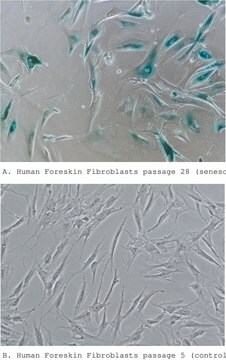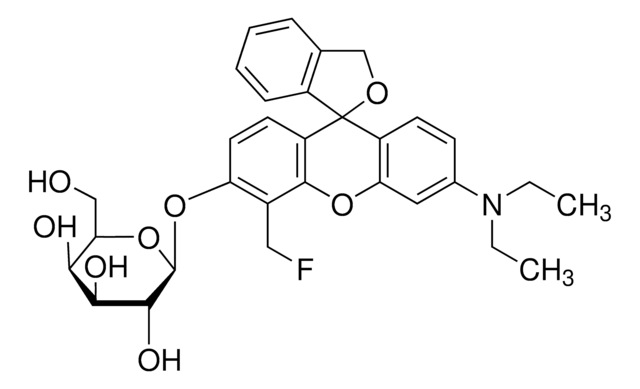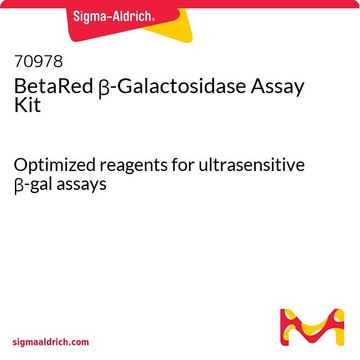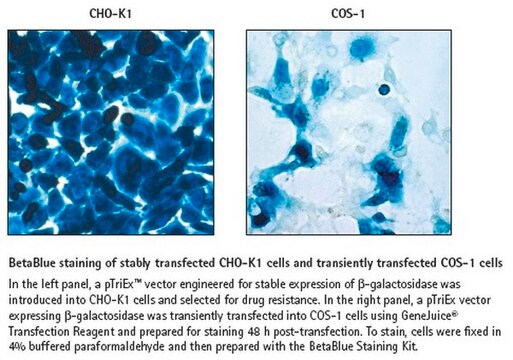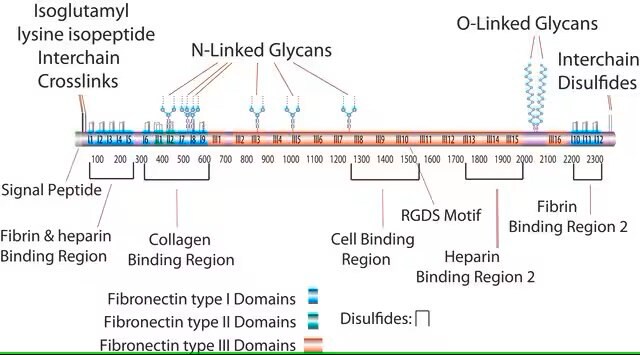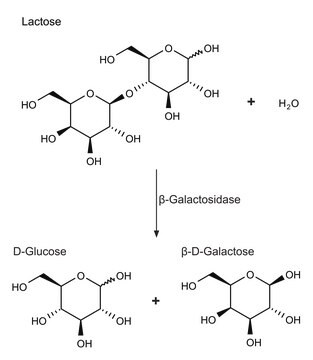GALS
β-Galactosidase Reporter Gene Staining Kit
Synonym(s):
β-galactosidase, LacZ
Sign Into View Organizational & Contract Pricing
All Photos(1)
About This Item
UNSPSC Code:
12161503
NACRES:
NA.32
Recommended Products
usage
kit sufficient for 100 tests (using a 3.5 cm dish)
Quality Level
technique(s)
microbe id | staining: suitable
shipped in
dry ice
storage temp.
−20°C
General description
β-galactosidase (β-gal) catalyzes the conversion of X-gal to galactose and 5-bromo-4-chloro-3-hydroxyindole. The functionality of β-gal is indirectly measured by the blue precipitate of dimeric 5-bromo-4-chloro-3-hydroxyindole in the presence of potassium ferricyanide or ferrocyanide. The colorimetric detection methods also use other substrates of β-gal like O-nitrophenyl-β-D-galactopyranoside (ONPG). β-gal is a cost-effective, simple and standard reporter system. The Galactosidase Reproter Gene Staining Kit provides a method for determining the percentage of cells transfected with the plasmid expressing the β-galactosidase gene, LacZ. It can also be used to visualize the specific expression of the reporter gene in tissue sections by microscopy.
Application
β-Galactosidase Reporter Gene Staining Kit has been used for histochemical staining of animal cells or tissues such as:
- sagittal brain sections in histoenzymology
- pancreas or colon sections in β-galactosidase reporter gene assay
- mice E10.5 -11.5 embryo and embryo sections
Other Notes
The substrate used in this kit is X-Gal (5-bromo-4-chloro-3-indolyl β-D-galactopyranoside) which results in an indigo blue-colored staining of transfected cells and tissues. This test provides a method for determining the percentage of transfected cells that are expressing LacZ or for microscopically visualizing reporter gene expression in tissue sections.
related product
Product No.
Description
Pricing
Signal Word
Danger
Hazard Statements
Precautionary Statements
Hazard Classifications
Acute Tox. 3 Inhalation - Acute Tox. 4 Dermal - Acute Tox. 4 Oral - Aquatic Chronic 3 - Carc. 1B - Eye Dam. 1 - Flam. Liq. 3 - Muta. 2 - Resp. Sens. 1 - Skin Corr. 1B - Skin Sens. 1 - STOT SE 3
Target Organs
Respiratory system
Supplementary Hazards
Storage Class Code
3 - Flammable liquids
Flash Point(F)
132.8 °F
Flash Point(C)
56 °C
Choose from one of the most recent versions:
Already Own This Product?
Find documentation for the products that you have recently purchased in the Document Library.
Customers Also Viewed
D Long et al.
Journal of virology, 68(9), 5890-5898 (1994-09-01)
Human immunodeficiency virus type 1 (HIV-1) infects some cell types which lack CD4, demonstrating that one or more alternative viral receptors exist. One such receptor is galactosylceramide (GalCer), a glycosphingolipid distributed widely in the nervous system and in colonic epithelial
GPR120 (FFAR4) is preferentially expressed in pancreatic delta cells and regulates somatostatin secretion from murine islets of Langerhans
Stone VM, et al.
Diabetologia, 57(6), 1182-1191 (2014)
An improved method with high sensitivity and low background in detecting low beta-galactosidase expression in mouse embryos
Shen X, et al.
PLoS ONE, 12(5), e0176915-e0176915 (2017)
Ioannis Mantas et al.
International journal of molecular sciences, 22(16) (2021-08-28)
Trace Amine-Associated Receptor 1 (TAAR1) is a potential target for the treatment of depression and other CNS disorders. However, the precise functional roles of TAAR1 to the actions of clinically used antidepressants remains unclear. Herein, we addressed these issues employing
Virginia M Stone et al.
Diabetologia, 57(6), 1182-1191 (2014-03-26)
The NEFA-responsive G-protein coupled receptor 120 (GPR120) has been implicated in the regulation of inflammation, in the control of incretin secretion and as a predisposing factor influencing the development of type 2 diabetes by regulation of islet cell apoptosis. However
Our team of scientists has experience in all areas of research including Life Science, Material Science, Chemical Synthesis, Chromatography, Analytical and many others.
Contact Technical Service